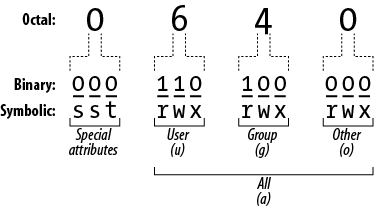Name
chmod — stdin stdout - file -- opt --help --version
Synopsis
chmod [options]permissions files
The chmod (change mode)
command protects files and directories from unauthorized users on
the same system, by setting access permissions. Typical permissions
are read, write, and execute, and they may be limited to the file
owner, the file’s group owner, and/or other users. The permissions
argument can take three different forms:
--reference=file, to set the same permissions as another given file.An octal number, up to four digits long, that specifies the file’s absolute permissions in bits, as in Figure 1-6. The leftmost digit is special (described later) and the second, third, and fourth represent the file’s owner, the file’s group, and all users.
One or more strings specifying absolute or relative permissions (i.e., relative to the file’s existing permissions). For example,
a+rmakes a file readable by all users.

Figure 1-6. File permission bits explained
In the third form, each string consists of three parts: an optional scope, a command, and permissions.
- Scope (optional)
ufor user,gfor group,ofor other users not in the group,afor all users. The default isa.- Command
+to add permissions;−to remove permissions; or=to set absolute permissions, ignoring existing ones.- Permissions
rfor read,wfor write/modify,xfor execute (for directories, this is permission tocdinto ...
Get Linux Pocket Guide, 2nd Edition now with the O’Reilly learning platform.
O’Reilly members experience books, live events, courses curated by job role, and more from O’Reilly and nearly 200 top publishers.

